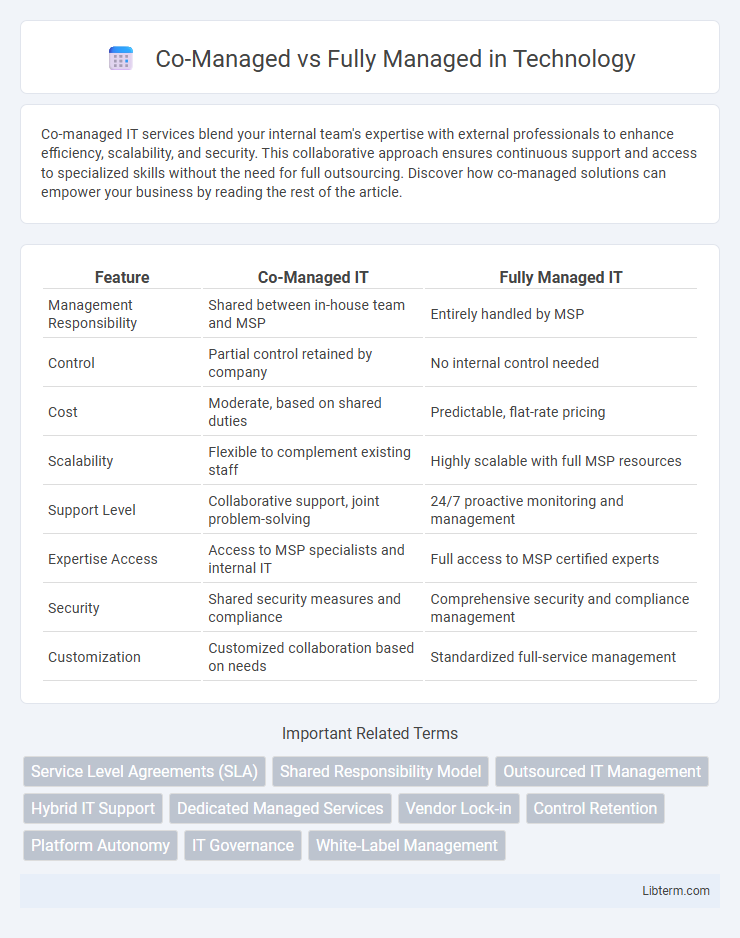Co-managed IT services blend your internal team's expertise with external professionals to enhance efficiency, scalability, and security. This collaborative approach ensures continuous support and access to specialized skills without the need for full outsourcing. Discover how co-managed solutions can empower your business by reading the rest of the article.
Table of Comparison
| Feature | Co-Managed IT | Fully Managed IT |
|---|---|---|
| Management Responsibility | Shared between in-house team and MSP | Entirely handled by MSP |
| Control | Partial control retained by company | No internal control needed |
| Cost | Moderate, based on shared duties | Predictable, flat-rate pricing |
| Scalability | Flexible to complement existing staff | Highly scalable with full MSP resources |
| Support Level | Collaborative support, joint problem-solving | 24/7 proactive monitoring and management |
| Expertise Access | Access to MSP specialists and internal IT | Full access to MSP certified experts |
| Security | Shared security measures and compliance | Comprehensive security and compliance management |
| Customization | Customized collaboration based on needs | Standardized full-service management |
Understanding Co-Managed and Fully Managed IT Services
Co-Managed IT services involve collaboration between an internal IT team and an external managed service provider, allowing businesses to retain control while accessing specialized expertise and scalable support. Fully Managed IT services outsource all IT responsibilities to a third-party provider, delivering comprehensive management, proactive monitoring, and strategic planning to optimize performance and security. Understanding these models enables organizations to choose flexible solutions tailored to their resource capacity and operational goals.
Key Differences Between Co-Managed and Fully Managed Models
Co-managed IT services combine internal teams with external experts, allowing shared responsibilities and greater control over IT operations, while fully managed models delegate complete IT management to service providers, ensuring 24/7 support and proactive maintenance. Key differences include the level of control, with co-managed solutions offering collaborative decision-making and fully managed services providing end-to-end management. Co-managed models are ideal for organizations seeking to augment internal capabilities, whereas fully managed services are suited for businesses prioritizing comprehensive outsourcing and reduced internal IT burdens.
Pros and Cons of Co-Managed IT Services
Co-Managed IT services offer organizations enhanced control over their IT environment while benefiting from external expertise, enabling faster issue resolution and improved security without the full cost of outsourcing. The primary advantage includes scalability and flexibility, allowing internal teams to focus on strategic initiatives while external providers handle routine maintenance and complex challenges. Potential downsides involve dependency on the vendor for critical support and possible communication gaps between internal and external teams, which can affect response times and workflow integration.
Pros and Cons of Fully Managed IT Services
Fully managed IT services offer continuous monitoring, proactive maintenance, and comprehensive support, reducing downtime and freeing internal teams to focus on core business tasks. However, these services can be costly and may limit internal control over IT decisions and customization options. This approach suits organizations seeking expert management and scalability without the burden of in-house IT infrastructure.
Cost Comparison: Co-Managed vs Fully Managed
Co-managed IT services reduce costs by allowing organizations to maintain in-house control while outsourcing complex or resource-intensive functions, thereby lowering the need for full-time staff and expensive infrastructure. Fully managed services typically incur higher fees due to comprehensive coverage, 24/7 monitoring, and complete responsibility for IT environment management. Businesses aiming to optimize expenses must evaluate workload scope, internal capabilities, and desired service levels when choosing between co-managed and fully managed options.
Ideal Scenarios for Choosing Co-Managed Services
Co-managed services are ideal for organizations seeking to enhance their existing IT security teams without completely relinquishing control, allowing internal staff to focus on strategic initiatives while external experts handle specialized tasks. Companies with in-house expertise that require scalable support during peak workloads or around-the-clock monitoring benefit from the flexibility and collaborative approach of co-managed models. This hybrid setup suits businesses aiming to maintain oversight of critical security functions while leveraging external resources for threat detection, incident response, and compliance management.
When to Opt for Fully Managed IT Solutions
Opt for fully managed IT solutions when your organization requires comprehensive support, including 24/7 monitoring, proactive maintenance, and rapid issue resolution without needing in-house IT expertise. Businesses experiencing rapid growth, complex compliance demands, or those lacking dedicated IT staff benefit most from fully managed services. This approach ensures seamless technology integration, enhanced cybersecurity, and predictable IT costs, enabling core focus on strategic objectives.
Security Implications: Co-Managed vs Fully Managed
Co-managed security solutions offer organizations greater control over their security policies and tools, enabling customized responses and real-time adjustments tailored to internal risk assessments. Fully managed security services provide comprehensive, expert-driven threat detection and incident response, leveraging advanced technologies and continuous monitoring to reduce the likelihood of breaches. The choice impacts data privacy, compliance adherence, and response agility, with co-managed models balancing internal oversight and external expertise, while fully managed models prioritize outsourced accountability and proactive defense.
How to Transition Between Co-Managed and Fully Managed
Transitioning between co-managed and fully managed IT services involves assessing current infrastructure, setting clear roles, and establishing communication protocols to ensure seamless service integration. Organizations should conduct a thorough gap analysis to identify responsibilities shifting from internal teams to external providers or vice versa, followed by phased implementation to minimize operational disruption. Monitoring key performance indicators (KPIs) and maintaining continuous collaboration between in-house staff and managed service providers (MSPs) ensures effective alignment with business objectives throughout the transition process.
Choosing the Right IT Management Model for Your Business
Selecting the right IT management model depends on your business's size, resources, and security requirements. Co-managed IT offers flexibility by combining your internal team's knowledge with external experts' specialized skills, promoting collaborative problem-solving and cost-efficiency. Fully managed IT provides comprehensive oversight, ensuring 24/7 monitoring, proactive maintenance, and expert support for businesses seeking to outsource all technical responsibilities.
Co-Managed Infographic

 libterm.com
libterm.com